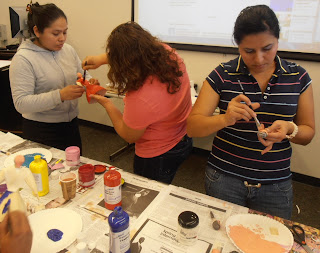There
is no better way of getting perceptions of a place than by talking to the
people that are new to that environment. The people in this case are
international students studying at Cal State University, Dominguez Hills
through a program named SEED.
 |
| Current SEED students with their Conflict Resolution and Leadership Professor, Richard Harris. Photo by Jocelyn Arana. |
Ana
Mancia, the president elected amongst the students, says that to her, the high
cost of living was part of the culture shock. She says, “Although some things
are less expensive in the U.S., there are other things such as food and housing
that cost less in El Salvador. I don’t know if it’s just California or the
country as a whole, but I would not be able to survive here with my salary back
home.” High cost of living is nothing new for Californians, who are used to
paying high process for homes, cars, and gas. Ana also mentioned that it was helpful
to live in an environment where many people spoke her native language, Spanish.
“I thought the language barrier would be a big problem at first, because my English
isn’t as fluent as I’d like it to be, but people here are generally open to
helping us understand something or giving us directions, if they can. It helped
with the adjustment process to be in a place of highly concentrated Spanish speakers.”
Because most of the SEED students come from rural parts of El Salvador, many of
them did not learn English until their adult life, which can make it difficult
to master the language. Many of them mention struggling with communicating with
American students and people here in general, but that it is all part of the
learning process.
Another
student, Armando Elias, says that he missed home the moment he arrived, but
says he has tried to remain busy. “There
is so much to do here, there are beaches, the outdoors, museums, shopping
centers, great restaurants with every type of food imaginable, and so many
cities within Los Angeles County, I want to see as much as I can while I am
here.”
These effects the students describe may be part of what is called the culture
shock curve. People who leave their country of origin for an extended amount of
time experience a culture shock curve, which expresses the highs and lows of
living in a new country.
In
comparison to life back home, the biggest differences the students see between
The United States and El Salvador is the sense of time and the sense of
community. They mentioned that life back home, even in big cities like San
Salvador, people take it easier than here, take long lunch breaks, and do not
usually work as long hours as they do here in America. Jose Lopez, a fourth
grade math teacher says, “What surprises me is how fast people live here in
their daily lives. They spend a lot of time in their cars, and on their phones.
It’s as if they always have somewhere to go or somewhere to be, and punctuality
is very important. That concept of time is not the same back home.” He
mentioned the fact that many people in his town of Santa Ana, El Salvador are
home by dinnertime, or at least by the time it is dark outside.
The
concept of time is an interesting dynamic that fluctuates in different parts of
the world. While some countries, usually individualistic societies, have a
strict notion of time and punctuality, collectivistic societies, like Jose’s
town in El Salvador focus more on the group rather than the self. They like to
eat meals together, are more likely to carpool or ride share to work or school,
and have a sense of community where they live.
The
SEED group is taking courses in teaching techniques for at risk youth at CSUDH,
and they arrived this January and leave mid-June. Although most of them are
eager to return home to their families, they all say they are happy to have been
able to live this experience and hope to visit Southern California again
someday.




















